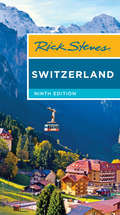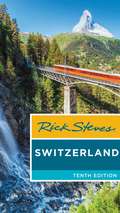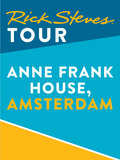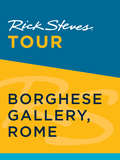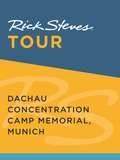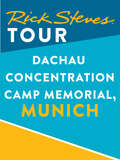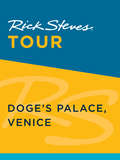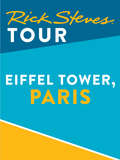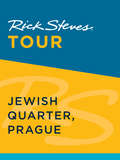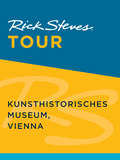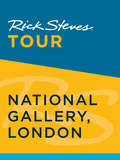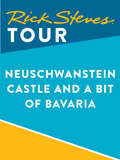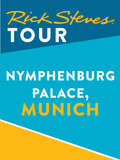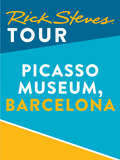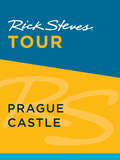- Table View
- List View
Rick Steves Switzerland: Including Berlin, Munich, Salzburg And Vienna City Maps (Rick Steves)
by Rick StevesCross the Alps in a cable car, cruise Lake Geneva, and visit a medieval château: with Rick Steves on your side, Switzerland can be yours!Inside Rick Steves Switzerland you'll find:Comprehensive coverage for spending a week or more exploring SwitzerlandRick's strategic advice on how to get the most out of your time and money, with rankings of his must-see favoritesTop sights and hidden gems, from bustling Zürich to the cozy small-town atmosphere of AppenzellHow to connect with culture: Chat with friendly Swiss locals at mountain retreats, swim in the alpine waters of the Aare River, and treat yourself to delicious cheese fondue Beat the crowds, skip the lines, and avoid tourist traps with Rick's candid, humorous insightThe best places to eat, sleep, and relax over wine and Swiss chocolateSelf-guided walking tours of lively neighborhoods and mountain townsDetailed maps for exploring on the go, including scenic railroad journeys such as the Golden Pass, Gotthard Panorama Express, Bernina Express, Glacier Express, and ChurUseful resources including a packing list, German, French, and Italian phrase guides, a historical overview, and recommended reading, as well as tips on visiting Switzerland in the winterOver 400 bible-thin pages include everything worth seeing without weighing you downComplete, up-to-date information on Zürich, Luzern, Central Switzerland, Bern, Murten, Avenches, Gimmelwald and the Berner Oberland, Zermatt and the Matterhorn, Appenzell, Lausanne, Château de Chillon, Montreux, Gruyères, Lugano, Pontresina, Samedan, St. Moritz, and moreMake the most of every day and every dollar with Rick Steves Switzerland.
Rick Steves Switzerland: Make The Most Of Every Day And Every Dollar (Rick Steves)
by Rick StevesCross the Alps in a cable car, cruise Lake Geneva, and tour a medieval château: with Rick Steves, Switzerland is yours to explore! Inside Rick Steves Switzerland you'll find:Comprehensive coverage for spending a week or more exploring SwitzerlandRick's strategic advice on how to get the most out of your time and money, with rankings of his must-see favoritesTop sights and hidden gems, from bustling Zürich to the cozy small-town atmosphere of AppenzellHow to connect with culture: Chat with friendly Swiss locals at a mountain retreat, swim in the alpine waters of the Aare River, and treat yourself to delicious cheese fondueBeat the crowds, skip the lines, and avoid tourist traps with Rick's candid, humorous insightThe best places to eat, sleep, and relax over wine and Swiss chocolateSelf-guided walking tours of lively neighborhoods and mountain townsDetailed maps for exploring on the goScenic railroad journeys such as the Golden Pass, Gotthard Panorama Express, Bernina Express, Glacier Express, and ChurUseful resources including a packing list, German, French, and Italian phrase guides, a historical overview, and recommended reading, plus tips for visiting Switzerland in the winterOver 400 bible-thin pages include everything worth seeing without weighing you downComplete, up-to-date information on Zürich, Luzern, Central Switzerland, Bern, Murten, Avenches, Gimmelwald and the Berner Oberland, Zermatt and the Matterhorn, Appenzell, Lausanne, Château de Chillon, Montreux, Gruyères, Lugano, Pontresina, Samedan, St. Moritz, and moreMake the most of every day and every dollar with Rick Steves Switzerland.
Rick Steves Tour: Anne Frank House, Amsterdam (Rick Steves)
by Rick Steves Gene OpenshawRick Steves' Tours eBooks are straightforward, self-guided tours of some of Europe's most popular museums, ancient buildings, and other points of interest, designed for easy reference on your mobile device or eReader. In Rick Steves' Tour: Anne Frank House, Amsterdam-for less than the price of a cappuccino-Rick shares his candid advice on how to get the most out of a visit to the Ann Frank House, including when to go, how much it costs, and what's worth your time once you're there. With Rick's knowledgeable, humorous writing in hand, you'll also learn some interesting historical facts about the museum along the way. Packed with indispensable tips and recommendations from America's expert on Europe, Rick Steves' Tour: Anne Frank House, Amsterdam is a tour guide in your pocket-and on your smartphone.Rick Steves' Tours and Walks are available for must-see locations throughout London, Paris, Rome, Florence, Venice, Amsterdam, Vienna, Budapest, Athens, and Istanbul.
Rick Steves Tour: Anne Frank House, Amsterdam (Rick Steves)
by Rick Steves Gene OpenshawRick Steves' Tours eBooks are straightforward, self-guided tours of some of Europe's most popular museums, ancient buildings, and other points of interest, designed for easy reference on your mobile device or eReader. In Rick Steves' Tour: Anne Frank House, Amsterdam-for less than the price of a cappuccino-Rick shares his candid advice on how to get the most out of a visit to the Ann Frank House, including when to go, how much it costs, and what's worth your time once you're there. With Rick's knowledgeable, humorous writing in hand, you'll also learn some interesting historical facts about the museum along the way. Packed with indispensable tips and recommendations from America's expert on Europe, Rick Steves' Tour: Anne Frank House, Amsterdam is a tour guide in your pocket-and on your smartphone.
Rick Steves Tour: Borghese Gallery, Rome (Rick Steves)
by Rick Steves Gene OpenshawRick Steves' Tours eBooks are straightforward, self-guided tours of some of Europe's most popular museums, ancient buildings, and other points of interest, designed for easy reference on your mobile device or eReader. In Rick Steves' Tour: Borghese Gallery, Rome-for less than the price of a cappuccino-Rick shares his candid advice on how to get the most out of a visit to the Borghese Gallery, including when to go, how much it costs, and what's worth your time once you're there. With Rick's knowledgeable, humorous writing in hand, you'll also learn some interesting historical facts about the museum along the way. Packed with indispensable tips and recommendations from America's expert on Europe, Rick Steves' Tour: Borghese Gallery, Rome is a tour guide in your pocket-and on your smartphone.Rick Steves' Tours and Walks are available for must-see locations throughout London, Paris, Rome, Florence, Venice, Amsterdam, Vienna, Budapest, Athens, and Istanbul.
Rick Steves Tour: Dachau Concentration Camp Memorial, Munich (Rick Steves)
by Rick StevesRick Steves' Tours eBooks are straightforward, self-guided tours of some of Europe's most popular museums, ancient buildings, and other points of interest, designed for easy reference on your mobile device or eReader. In Rick Steves' Tour: Dachau Concentration Camp Memorial, Munich, Rick shares his candid advice on how to get the most out of a visit to the Dachau Concentration Camp Memorial, including when to go, how much it costs, and what to see once you're there. With Rick's knowledgeable writing in hand, you'll also learn some interesting historical facts about the museum along the way. Packed with indispensable tips and recommendations from America's expert on Europe, Rick Steves' Tour: Dachau Concentration Camp Memorial, Munich is a tour guide in your pocket-and on your smartphone.Rick Steves' Tours and Walks are available for must-see locations throughout London, Paris, Rome, Florence, Venice, Amsterdam, Vienna, Budapest, Athens, and Istanbul.
Rick Steves Tour: Dachau Concentration Camp Memorial, Munich (Rick Steves)
by Rick StevesRick Steves' Tours eBooks are straightforward, self-guided tours of some of Europe's most popular museums, ancient buildings, and other points of interest, designed for easy reference on your mobile device or eReader. In Rick Steves' Tour: Dachau Concentration Camp Memorial, Munich, Rick shares his candid advice on how to get the most out of a visit to the Dachau Concentration Camp Memorial, including when to go, how much it costs, and what to see once you're there. With Rick's knowledgeable writing in hand, you'll also learn some interesting historical facts about the museum along the way. Packed with indispensable tips and recommendations from America's expert on Europe, Rick Steves' Tour: Dachau Concentration Camp Memorial, Munich is a tour guide in your pocket-and on your smartphone.Rick Steves' Tours and Walks are available for must-see locations throughout London, Paris, Rome, Florence, Venice, Amsterdam, Vienna, Budapest, Athens, and Istanbul.
Rick Steves Tour: Doge's Palace, Venice (Rick Steves Tour Ser.)
by Rick Steves Gene OpenshawRick Steves' Pocket guidebooks truly are a "tour guide in your pocket.” Each colorful, compact 280-page book includes Rick's advice for prioritizing your time, whether you're spending 1 or 7 days in a city. Everything a busy traveler needs is easy to access: a neighborhood overview, city walks and tours, sights, handy food and accommodations charts, an appendix packed with information on trip planning and practicalities, and a fold-out city map.Rick Steves' Pocket Venice includes the following walks and tours: St. Mark's Square Tour St. Mark's Basilica Tour Doge's Palace Tour Frari Church Tour St. Mark's to Rialto Walk Rialto to Frari Church Walk St. Mark's to San Zaccaria Walk
Rick Steves Tour: Eiffel Tower, Paris (Rick Steves)
by Rick Steves Steve Smith Gene OpenshawRick Steves' Tours eBooks are straightforward, self-guided tours of some of Europe's most popular museums, ancient buildings, and other points of interest, designed for easy reference on your mobile device or eReader. In Rick Steves' Tour: Eiffel Tower, Paris-for less than the price of a café au lait-Rick shares his candid advice on how to get the most out of a visit to the Eiffel Tower, including when to go, how much it costs, and what's worth your time once you're there. With Rick's knowledgeable, humorous writing in hand, you'll also learn some interesting historical facts about the tower along the way. Packed with indispensable tips and recommendations from America's expert on Europe, Rick Steves' Tour: Eiffel Tower, Paris is a tour guide in your pocket-and on your smartphone.Rick Steves' Tours and Walks are available for must-see locations throughout London, Paris, Rome, Florence, Venice, Amsterdam, Vienna, Budapest, Athens, and Istanbul.
Rick Steves Tour: Eiffel Tower, Paris (Rick Steves)
by Rick Steves Steve Smith Gene OpenshawRick Steves' Tours eBooks are straightforward, self-guided tours of some of Europe's most popular museums, ancient buildings, and other points of interest, designed for easy reference on your mobile device or eReader. In Rick Steves' Tour: Eiffel Tower, Paris-for less than the price of a café au lait-Rick shares his candid advice on how to get the most out of a visit to the Eiffel Tower, including when to go, how much it costs, and what's worth your time once you're there. With Rick's knowledgeable, humorous writing in hand, you'll also learn some interesting historical facts about the tower along the way. Packed with indispensable tips and recommendations from America's expert on Europe, Rick Steves' Tour: Eiffel Tower, Paris is a tour guide in your pocket-and on your smartphone.Rick Steves' Tours and Walks are available for must-see locations throughout London, Paris, Rome, Florence, Venice, Amsterdam, Vienna, Budapest, Athens, and Istanbul.
Rick Steves Tour: Hofburg Imperial Apartments, Vienna (Rick Steves)
by Rick StevesRick Steves' Tours eBooks are straightforward, self-guided tours of some of Europe's most popular museums, ancient buildings, and other points of interest, designed for easy reference on your mobile device or eReader. In Rick Steves' Tour: Hofburg Imperial Apartments, Vienna-for less than the price of a cappuccino-Rick shares his candid advice on how to get the most out of a visit to the Hofburg Imperial Apartments, including when to go, how much it costs, and what's worth your time once you're there. With Rick's knowledgeable, humorous writing in hand, you'll also learn some interesting historical facts about the royal rooms along the way. Packed with indispensable tips and recommendations from America's expert on Europe, Rick Steves' Tour: Hofburg Imperial Apartments, Vienna is a tour guide in your pocket-and on your smartphone.Rick Steves' Tours and Walks are available for must-see locations throughout London, Paris, Rome, Florence, Venice, Amsterdam, Vienna, Budapest, Athens, and Istanbul.
Rick Steves Tour: Hofburg Treasury, Vienna (Rick Steves)
by Rick StevesRick Steves' Tours eBooks are straightforward, self-guided tours of some of Europe's most popular museums, ancient buildings, and other points of interest, designed for easy reference on your mobile device or eReader. In Rick Steves' Tour: Hofburg Treasury, Vienna-for less than the price of a cappuccino-Rick shares his candid advice on how to get the most out of a visit to the Hofburg Treasury, including when to go, how much it costs, and what's worth your time once you're there. With Rick's knowledgeable, humorous writing in hand, you'll also learn some interesting historical facts about the royal rooms along the way. Packed with indispensable tips and recommendations from America's expert on Europe, Rick Steves' Tour: Hofburg Treasury, Vienna is a tour guide in your pocket-and on your smartphone.Rick Steves' Tours and Walks are available for must-see locations throughout London, Paris, Rome, Florence, Venice, Amsterdam, Vienna, Budapest, Athens, and Istanbul.
Rick Steves Tour: Jewish Quarter, Prague (Rick Steves Tour Ser.)
by Rick Steves Honza VihanRick Steves' Pocket guidebooks truly are a "tour guide in your pocket.” Each colorful, compact book includes Rick's advice for prioritizing your time, whether you're spending 1 or 7 days in a city. Everything a busy traveler needs is easy to access: a neighborhood overview, city walks and tours, sights, handy food and accommodations charts, an appendix packed with information on trip planning and practicalities, and a fold-out city map.Rick Steves' Pocket Prague covers sights including: Old Town Square, Charles Bridge, the Jewish Quarter, Wenceslas Square, Mucha Museum, Municipal House, the Museum of Communism, St. Vitus Cathedral, Prague Castle, and Lobkowicz Palace.
Rick Steves Tour: Kunsthistorisches Museum, Vienna (Rick Steves)
by Rick StevesRick Steves' Tours eBooks are straightforward, self-guided tours of some of Europe's most popular museums, ancient buildings, and other points of interest, designed for easy reference on your mobile device or eReader. In Rick Steves' Tour: Kunsthistorisches Museum, Vienna-for less than the price of a cappuccino-Rick shares his candid advice on how to get the most out of a visit to the Kunsthistorisches Museum, including when to go, how much it costs, and what's worth your time once you're there. With Rick's knowledgeable, humorous writing in hand, you'll also learn some interesting historical facts about the museum along the way. Packed with indispensable tips and recommendations from America's expert on Europe, Rick Steves' Tour: Kunsthistorisches Museum, Vienna is a tour guide in your pocket-and on your smartphone.Rick Steves' Tours and Walks are available for must-see locations throughout London, Paris, Rome, Florence, Venice, Amsterdam, Vienna, Budapest, Athens, and Istanbul.
Rick Steves Tour: Munich Residenz Tour (Rick Steves)
by Rick StevesRick Steves' Tours eBooks are straightforward, self-guided tours of some of Europe's most popular museums, ancient buildings, and other points of interest, designed for easy reference on your mobile device or eReader. In Rick Steves' Tour: Munich Residenz Tour, Rick shares his candid advice on how to get the most out of a visit to the Munich Residenz, including when to go, how much it costs, and what to see once you're there. With Rick's knowledgeable writing in hand, you'll also learn some interesting historical facts along the way. Packed with indispensable tips and recommendations from America's expert on Europe, Rick Steves' Tour: Munich Residenz Tour is a tour guide in your pocket-and on your smartphone.Rick Steves' Tours and Walks are available for must-see locations throughout London, Paris, Rome, Florence, Venice, Amsterdam, Vienna, Budapest, Athens, and Istanbul.
Rick Steves Tour: Munich Residenz Tour (Rick Steves)
by Rick StevesRick Steves' Tours eBooks are straightforward, self-guided tours of some of Europe's most popular museums, ancient buildings, and other points of interest, designed for easy reference on your mobile device or eReader. In Rick Steves' Tour: Munich Residenz Tour, Rick shares his candid advice on how to get the most out of a visit to the Munich Residenz, including when to go, how much it costs, and what to see once you're there. With Rick's knowledgeable writing in hand, you'll also learn some interesting historical facts along the way. Packed with indispensable tips and recommendations from America's expert on Europe, Rick Steves' Tour: Munich Residenz Tour is a tour guide in your pocket-and on your smartphone.Rick Steves' Tours and Walks are available for must-see locations throughout London, Paris, Rome, Florence, Venice, Amsterdam, Vienna, Budapest, Athens, and Istanbul.
Rick Steves Tour: Museum Quarter Art Museums, Munich (Rick Steves)
by Rick StevesRick Steves' Tours eBooks are straightforward, self-guided tours of some of Europe's most popular museums, ancient buildings, and other points of interest, designed for easy reference on your mobile device or eReader. In Rick Steves' Tour: Museum Quarter Art Museums, Munich, Rick shares his candid advice on how to get the most out of a visit to the Museum Quarter Art Museums, including when to go, how much it costs, and what to see once you're there. With Rick's knowledgeable writing in hand, you'll also learn some interesting historical facts about the museums along the way. Packed with indispensable tips and recommendations from America's expert on Europe, Rick Steves' Tour: Museum Quarter Art Museums, Munich is a tour guide in your pocket-and on your smartphone.Rick Steves' Tours and Walks are available for must-see locations throughout London, Paris, Rome, Florence, Venice, Amsterdam, Vienna, Budapest, Athens, and Istanbul.
Rick Steves Tour: Museum Quarter Art Museums, Munich (Rick Steves)
by Rick StevesRick Steves' Tours eBooks are straightforward, self-guided tours of some of Europe's most popular museums, ancient buildings, and other points of interest, designed for easy reference on your mobile device or eReader. In Rick Steves' Tour: Museum Quarter Art Museums, Munich, Rick shares his candid advice on how to get the most out of a visit to the Museum Quarter Art Museums, including when to go, how much it costs, and what to see once you're there. With Rick's knowledgeable writing in hand, you'll also learn some interesting historical facts about the museums along the way. Packed with indispensable tips and recommendations from America's expert on Europe, Rick Steves' Tour: Museum Quarter Art Museums, Munich is a tour guide in your pocket-and on your smartphone.Rick Steves' Tours and Walks are available for must-see locations throughout London, Paris, Rome, Florence, Venice, Amsterdam, Vienna, Budapest, Athens, and Istanbul.
Rick Steves Tour: National Gallery, London (Rick Steves)
by Rick Steves Gene OpenshawRick Steves' Tours eBooks are straightforward, self-guided tours of some of Europe's most popular museums, ancient buildings, and other points of interest, designed for easy reference on your mobile device or eReader. In Rick Steves' Tour: National Gallery, London-for less than the price of a cappuccino-Rick shares his candid advice on how to get the most out of a visit to the National Gallery, including when to go and what's worth your time once you're there. With Rick's knowledgeable, humorous writing in hand, you'll also learn some interesting historical facts about the museum along the way. Packed with indispensable tips and recommendations from America's expert on Europe, Rick Steves' Tour: National Gallery, London is a tour guide in your pocket-and on your smartphone.Rick Steves' Tours and Walks are available for must-see locations throughout London, Paris, Rome, Florence, Venice, Amsterdam, Vienna, Budapest, Athens, and Istanbul.
Rick Steves Tour: Neuschwanstein Castle and a Bit of Bavaria (Rick Steves)
by Rick StevesRick Steves' Tours eBooks are straightforward, self-guided tours of some of Europe's most popular museums, ancient buildings, and other points of interest, designed for easy reference on your mobile device or eReader. In Rick Steves' Tour: Neuschwanstein Castle and a Bit of Bavaria, Rick shares his candid advice on how to get the most out of a visit to the Neuschwanstein Castle, including when to go, how much it costs, and what to see once you're there. With Rick's knowledgeable writing in hand, you'll also learn some interesting historical facts along the way. Packed with indispensable tips and recommendations from America's expert on Europe, Rick Steves' Tour: Neuschwanstein Castle and a Bit of Bavaria, Munich is a tour guide in your pocket-and on your smartphone.Rick Steves' Tours and Walks are available for must-see locations throughout London, Paris, Rome, Florence, Venice, Amsterdam, Vienna, Budapest, Athens, and Istanbul.
Rick Steves Tour: Neuschwanstein Castle and a Bit of Bavaria (Rick Steves)
by Rick StevesRick Steves' Tours eBooks are straightforward, self-guided tours of some of Europe's most popular museums, ancient buildings, and other points of interest, designed for easy reference on your mobile device or eReader. In Rick Steves' Tour: Neuschwanstein Castle and a Bit of Bavaria, Rick shares his candid advice on how to get the most out of a visit to the Neuschwanstein Castle, including when to go, how much it costs, and what to see once you're there. With Rick's knowledgeable writing in hand, you'll also learn some interesting historical facts along the way. Packed with indispensable tips and recommendations from America's expert on Europe, Rick Steves' Tour: Neuschwanstein Castle and a Bit of Bavaria, Munich is a tour guide in your pocket-and on your smartphone.Rick Steves' Tours and Walks are available for must-see locations throughout London, Paris, Rome, Florence, Venice, Amsterdam, Vienna, Budapest, Athens, and Istanbul.
Rick Steves Tour: Nymphenburg Palace, Munich (Rick Steves)
by Rick StevesRick Steves' Tours eBooks are straightforward, self-guided tours of some of Europe's most popular museums, ancient buildings, and other points of interest, designed for easy reference on your mobile device or eReader. In Rick Steves' Tour: Nymphenburg Palace, Munich, Rick shares his candid advice on how to get the most out of a visit to the Nymphenburg Palace, including when to go, how much it costs, and what to see once you're there. With Rick's knowledgeable writing in hand, you'll also learn some interesting historical facts along the way. Packed with indispensable tips and recommendations from America's expert on Europe, Rick Steves' Tour: Nymphenburg Palace, Munich is a tour guide in your pocket-and on your smartphone.Rick Steves' Tours and Walks are available for must-see locations throughout London, Paris, Rome, Florence, Venice, Amsterdam, Vienna, Budapest, Athens, and Istanbul.
Rick Steves Tour: Nymphenburg Palace, Munich (Rick Steves)
by Rick StevesRick Steves' Tours eBooks are straightforward, self-guided tours of some of Europe's most popular museums, ancient buildings, and other points of interest, designed for easy reference on your mobile device or eReader. In Rick Steves' Tour: Nymphenburg Palace, Munich, Rick shares his candid advice on how to get the most out of a visit to the Nymphenburg Palace, including when to go, how much it costs, and what to see once you're there. With Rick's knowledgeable writing in hand, you'll also learn some interesting historical facts along the way. Packed with indispensable tips and recommendations from America's expert on Europe, Rick Steves' Tour: Nymphenburg Palace, Munich is a tour guide in your pocket-and on your smartphone.Rick Steves' Tours and Walks are available for must-see locations throughout London, Paris, Rome, Florence, Venice, Amsterdam, Vienna, Budapest, Athens, and Istanbul.
Rick Steves Tour: Picasso Museum, Barcelona (Rick Steves Tour)
by Rick StevesRick Steves' Walks eBooks are straightforward, self-guided walking tours through some of Europe's most popular destinations, designed for easy reference on your mobile device or eReader. In Rick Steves' Tour: Picasso Museum, Barcelona-for less than the price of a cappuccino-Rick shares his candid advice on how to get the most out of a visit to the museum, including when to go, how much it costs, and what to keep an eye out for once you're there. With Rick's knowledgeable, humorous writing in hand, you'll also learn some interesting historical facts about Pablo Picasso along the way. Packed with indispensable tips and recommendations from America's expert on Europe, Rick Steves' Tour: Picasso Museum, Barcelona is a tour guide in your pocket-and on your smartphone.
Rick Steves Tour: Prague Castle (Rick Steves Tour Ser.)
by Rick Steves Honza VihanRick Steves' Pocket guidebooks truly are a "tour guide in your pocket.” Each colorful, compact book includes Rick's advice for prioritizing your time, whether you're spending 1 or 7 days in a city. Everything a busy traveler needs is easy to access: a neighborhood overview, city walks and tours, sights, handy food and accommodations charts, an appendix packed with information on trip planning and practicalities, and a fold-out city map.Rick Steves' Pocket Prague covers sights including: Old Town Square, Charles Bridge, the Jewish Quarter, Wenceslas Square, Mucha Museum, Municipal House, the Museum of Communism, St. Vitus Cathedral, Prague Castle, and Lobkowicz Palace.
